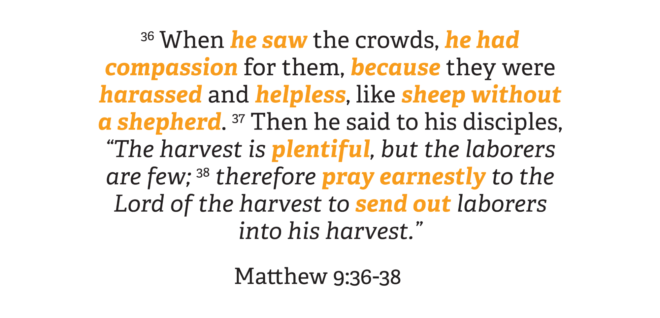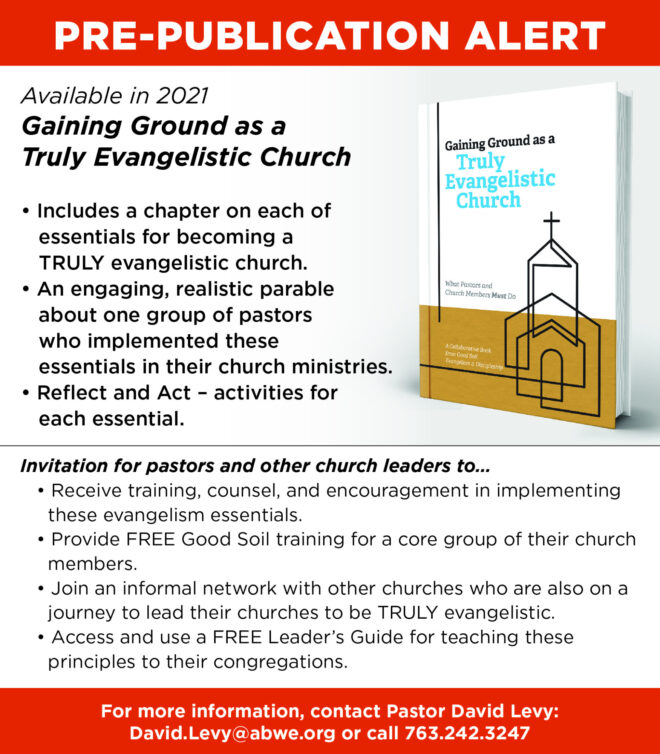The E Team: Building a Core Group of Christians with "Good Shepherd" Hearts 2nd Essential for a TRULY Evangelistic Church

Buy-in and participation from a core group of members from the congregation is important. No, it’s essential! This is the pastor’s first and possibly most challenging task—identify and recruit an E-Team from the congregation, folks who have a heart for lost sheep.
Peer leadership, or should I call it pew leadership, adds credibility to pastoral leadership in essential Christian tasks such as personal evangelism.
It is easy for people in the pew to think evangelism is solely the pastor’s job. While some church members may enjoy hearing the pastor share his personal experiences in building redemptive relationships and pointing people to Jesus, they may assume it is his theological training and Bible knowledge that makes it possible for him to evangelize effectively—“Because he’s a professional.”
What they don’t realize is that, in some ways, the non-theologically trained folks in the congregation have more potential than their pastor to be fruitful personal witnesses for Jesus.
A lot of unbelievers keep pastors at an arms-distance, because of what the word “pastor” connotes to them. While, on the other hand, most regular church members already have relationships with unbelievers—neighbors, co-workers, friends, and relatives—who already know and trust them.
If one or more ordinary members of the congregation begins to imitate the pastor’s evangelistic lifestyle, the fever for seeing people’s lives changed by the gospel will become increasingly contagious. With a little help from the pew, the “evangelism is (only) the pastor’s job” myth can be demythologized.
I’m not going to say this will always be easy, but I think the process is fairly simple. At the risk of making this sound too simple, let me suggest four steps.
Step One – Pray and identify potential members of a "Good Shepherd" core group, the beginnings of an E-Team.
Throughout my more than 50 years of ministry, I have found at least a few people in every church I’ve been a part of—from a small country church, to a large multi-site church—who have hearts for lost sheep. These are the people who:
- Often ask prayer for lost friends or loved ones.
- Share occasional stories of unbelievers to whom they are witnessing.
- Live consistent and boldly-Christian lives amidst a lot of unbelievers, on the job or elsewhere.
- Invite unsaved friends or family members to church, perhaps for special events, such as Christmas and Easter services.
- Quickly respond positively when you mention the possibility of providing evangelism training.
These are the kinds of people to be looking for initially. I suggest that you personally chat with these folks and gauge their interest in meeting with you to pray and to discuss how “we” can help “our” church be more broadly active in reaching “our” communities with God’s wonderful message of hope.
Step Two – Engage the initial evangelistic core group in praying the “Harvester’s Prayer.”
A Good Shepherd pastor may only be able to reach one lost sheep at a time. And even a core group of church members whose hearts are in tune with the Shepherd’s heart will need to expand. In fact, the most reliable indicator that a congregation is making progress toward becoming a TRULY evangelistic church is the gradual expansion of this core group. Expand the core with genuinely committed Christians, that’s a key mark of progress!
Jesus left us with a “how to” for expanding an evangelistic core group. It’s the way He built his E-Team. I call it the “Harvester’s Prayer.”

Praying the “Harvester’s Prayer,” works on two levels. Obviously, it is a plea to the Lord of the harvest to “send out laborers.” “Send out” (ἐκβάλλω in Greek)is stronger than it sounds in English. It literally means to “drive out,” “push out,” or “thrust out with great impulse or force,”—even used with reference to “casting out” demons. It suggests overcoming strong resistance.
I don’t know about you, but my selfish, introverted, want-to-be-liked selfresists evangelism. God can and God does work on the hearts of Christians, through earnest prayer, to push through that resistance. That’s the first reason we pray the Harvester’s Prayer.
Also, prayers directed to the Lord of the harvest work in the hearts of pray-ers, the people who are praying this prayer. It helps embolden them (us!) to push through their (our!) own resisting impulses when God opens doors that might lead to redemptive conversations and conversion discussions.
But who were these harassed, helpless, and directionless people—a huge crowd of them? They were common folks who were harassed by the Roman government and led astray by spiritually blind religious leaders. They were helpless pawns in the powerful hands of Rome and institutional Judaism. They were beaten down by secular forces, confused by religious laws and rituals—so much so, they were just generally hopeless. They followed Jesus because He offered a hopeful alternative, the same hope we have offer the crowds of our generation who live with different, but basically similar, needs.
In our day, it is very easy to see the “crowd” and not see their needs. Their comfortable houses, nice automobiles, and fashionable attire are deceptive—these externals mask their spiritual needs. But if they are not genuine “born again” Christians, they are sheep without the Shepherd, lost and clinging to an eternally dangerous precipice.
As it did with Jesus, seeing beyond their exteriors to their deep spiritual needs is what produces compassion in our hearts.

I suspect you have heard more emphasis on “the laborers are few” than “the harvest is plentiful.” And that is unfortunate, because it overlooks the positive side of the challenge we face.
Jesus was probably thinking of wheat fields, but I’ll change the agricultural metaphor a bit to be more visually understandable for most of us. Think of a huge apple orchard loaded down with ready-to-pick apples. The ripe apples are there! But if there are only two or three “pickers,” the harvest will be disappointing. Multiply the pickers and the fruit of the harvest will become increasingly plentiful.

We can’t blame the lack of conversions in our churches on the Biblical illiteracy and pluralism in our post-modern, post-Christian culture. The “harvest is plentiful,” today as it was in the first century Roman world.
Yes, there is some “low hanging fruit,” but much of it requires a lot more effort and patience to be picked.
Step Three – Begin the process of training the E-Team
One of the all-time classic books on this topic is Robert Coleman’s The Master Plan of Evangelism. Coleman expounded on the method Jesus used to achieve what our churches need to do. It’s a simple method really: find a few committed followers of Jesus and train them to reach and train others, who will reach and train others (ad infinitum). The concept is so Biblically apparent and simple, why haven’t more pastors implemented this “Master Plan” of Jesus in their churches?
Once a committed core group begins to gel, the next step is training. Jesus trained His core E-Team before training the broader group of His followers. And we can’t go wrong by emulating His methodology. More will be said about a broader congregational training in a later chapter, but it’s best to begin with the emerging E-Team.

Initial Training. Start with the Evangelism Essentials Visual Model. Present the model to the group and explain each facet, step-by-step, “building” the model as you go. As you lead the group through each “essential,” talk about implementation tactics for your church:
- What are the challenges we may face?
- What are some possible ways to counter these challenges?
- What are some additional ideas related to each “essential” that are not mentioned in the article?
- What are the practical steps to follow in getting started?
Prepare yourself for some “it won’t work here” resistance, but don’t let that discourage or defeat you. At this point you don’t want to get mired down on any singular point. Just introduce the concepts with enough detail for them to gain a general understanding. Give them the overview, the BIG picture.
Every local church is different, with different challenges in the process of evangelistic mobilization. Encourage your E-Team to be a part of tackling these challenges with you.
Next Step Training. One proven-to-be-effective way to equip your “twelve” (or “one” or “two” or more) is to accompany them to a Good Soil Evangelism and Discipleship Seminar. Not only will they be personally trained to share God’s story of hope “in a world of competing faiths and cultures,” but on the third day of the seminar week they will be trained and certified to team-teach the Basic Good Soil Seminar with you, back in your church.

Step Four – Engage the E-Team in leadership roles, based on their gifts and skills.
Engage members of the E-Team in helping you lead the church through this process of becoming a more-TRULY evangelistic church. But be sure that the person has demonstrated ability to perform an assigned task.
As you read the remaining articles in this series, be thinking about how you can share the load of these responsibilities with your team. The more they are engaged, the stronger their commitment will be.
Here’s a look back and a look forward to the entire set of articles in this “Twelve Essentials to a TRULY Evangelistic Church” series:
- The Evangelistic Pastor
- The E-Team
- THE Mission
- Local Focus
- Congregational Warmth
- Equipped Congregation
- Basic Discipleship
- Peer Accountability
- Evangelistic Praying
- Shared Rejoicing
- Strategic Simplicity
- Relentless Pursuit




